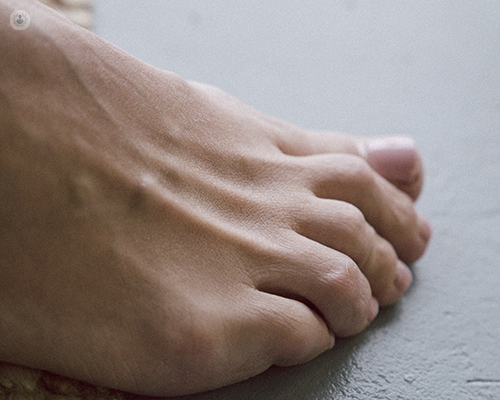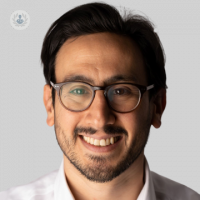Toe deformities: everything you need to know
Written in association with:What are the most common types of toe deformities?
The most common types of toe deformities are hammer toe, claw toe and mallet toe.
Hammer toe is when there is bending at the first knuckle within a lesser toe itself. With the claw toe, there is bending in both the knuckles within the toe itself.
Mallet toe is where there is bending in the far kncuckle of the toe, closet to the toenail of the toe itself. These toe deformities are mainly in regards to the lesser toe (ones other than the big toe) and occur in different conditions.

Hammer toe most frequently affects the second toe and is commonly found in people who have had a bunion or hallux valgas.
Symptoms usally occur due to rubbing of the top of the toe against footwear and rubbing of the tip of the toe on footwear or the floor.
Claw toe more commonly affects multiple lesser toes. People who have claw toe can also get pain at the top of and the tip of the toe where it rubs against the floor.
Mallet toe usually affects the second toe but can affect multiple other toes. Symptoms tend to be due to rubbing against the tip of the toe or the nail as well and sometimes getting associated nail changes.
Hammer and claw toe may present with pain on the ball of the foot. Due to the fact that the toe itself comes upwards, with those specific deformities, bones on the underside of the foot can be exposed to increased pressure, causing pain underneath the ball of the foot.
What are the main causes of toe deformities?
There are multiple factors which can lead to toe deformities. Some can be treated but not all.
Genetically pre-dispositioned deformities cannot be treated. This is multi-factorial but often people in the same family have similar toes and consequently similar deformities.
Footwear can affect the deformities. If we choose footwear which is narrow in the forefoot, this crowds toes together, which can potentially lead to toe deformities. Pre-exisitng toe deformities can worsen due to this footwear. It is better to use footwear with a wider box to accommodate deformities.
Toe deformities are associated with bunions. It is common to have a bunion which gets more severe and starts affecting the lesser toes, most commonly the second ones. This not only hammers but causes soreness at the top of the second toe.
What is the most effective treatment for toe deformities?
Treatment depends not only on the deformity itself but the patient. It is bespoke not just the patient’s foot but their general health, activities, what they like to do in life and how the deformities are affecting them.
It’s worthwhile starting off with some non-operative treatments to help alleviate the symptoms. There’s very little evidence to suggest that preventative measures can influence the natural history or progression of the toe deformity.
Some therories and evidence suggest that a flat foot can contribute to certain toe deformities, as well a high arch foot which can also contribue to some toe deformities.
Gastrocnemius, a tightness of the top calf muscle, can contribute to increased pressure underneath the ball of the foot, which can be implicated in the development of toe deformities. Streching the calf muscles by wearing insoles if you have a flat foot can be beneficial.
Wearing shoes which are not too short, particularly if the second toe is longer, can prevent developing pain at the tip of the second toe and potentially a Mallet toe.
When toe deformities have been established, you can try a silicone toe protector and shoes with a wider fit.
When deformities are associated with a bunion, toe spacers and hallux valgus or bunion splints or pads can be helpful. However these take up space within the shoe and would require a wider fitting shoe, which isn’t always comfortable.
Sleeves with padding that can be used to give extra padding at the ball of the foot to help with symptoms.
What is hammer toe is and how it is caused?
Hammer toe usually involves the second toe and sometimes the third.
It usually happens when people have some reason for them to overload the second and other lesser toes. It is commonly seen as a bunion.
The tripod effect, based on the big toe, little toe and the heel forming a tripod for the body to stand on, is affected because the big toe is less able to perform its job with a bunion, compared to when it’s not without one.
As a result, the lesser toe, metatarsal head, (the long bones which lead to the lesser toes) are overloaded and as a result, can develop soft tissue problems, that lead into loosening of the joints, potential instabiity of the joints and the subsuquent, lesser toe deformities.
An imbalance in the muscles contibutes to this. The process can be exacerbated by aging and other conditions such as inflammatory disorders or metabolic disorders like rheumatoid arthritis or diabetes.
Tightness of the calf muscle can contribute to this and lead to a gradual weakening of the structures that hold the toe down, therefore allowing the process for the hamer toe to occur. Due to the way the longer and shorter muscles and tendons around the toes act, the toe assumes these typical positions of hammer toe, claw toe or mallet toe, based on the exact cause of them.
Is surgical intervention required?
Surgical intervention is not always required. As previously mentioned before, not much can be done to prevent these sorts of deformities, therefore patients assume a reactive stance as opposed to a proactive stance.
Deformities are treated based on if the symtpoms are present, not for appearance as generally people are not usually satsified with results of surgery because it always ends up looking ‘not normal’.
Treatment depends on where the symptoms come from and the exact deformity. For example, treatment for pain at the top of the toe will differ to treatment at the tip of the toe.
If it’s a flexible deformity, soft tissue procedures are optional but if it’s fixed, where doctors are unable to correct it, when they do the assessment they will have to rely on more joint destructive procedures in order to deal with those.
If the lesser toe deformity has an effect on the joint where the lesser toe joins the foot, then there will be a different set of options available during the surgical correction, which can incolve shortening the long bones which lead to the lesser toes and sometimes doing procedures within that joint.
A calf muscle release may be needed to help with the symptoms, due to the role of calf muscle tightness.
Due to the crucial role of the big toe, it may not be possible to address the second toe deformity without addressing the bunion or the big toe.


